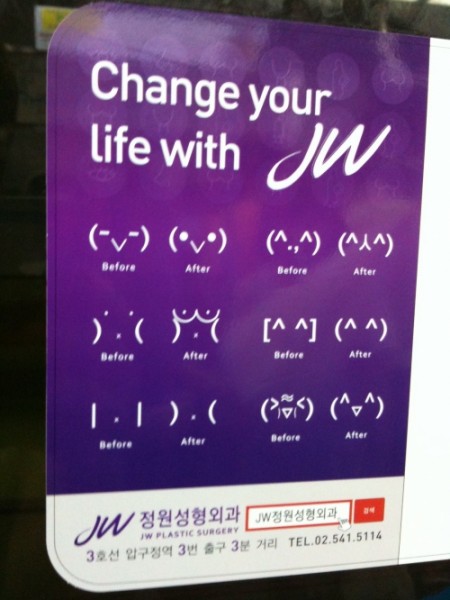![]() I love emoticons. In every single email and text I write, I try to use them at least once. Whether it’s a business email or a break up text, it doesn’t matter. For example, in a business email I may write, “Sorry, I don’t have the widgets! : ( “ And in a break up text, I may write, “I’m glad I never have to see you again. : )”
I love emoticons. In every single email and text I write, I try to use them at least once. Whether it’s a business email or a break up text, it doesn’t matter. For example, in a business email I may write, “Sorry, I don’t have the widgets! : ( “ And in a break up text, I may write, “I’m glad I never have to see you again. : )”
First, for those of you stuck in the 18th century, an emoticon is a “is a facial expression pictorially represented by punctuation and letters, usually to express a writer’s mood.” A lot of people think that emoticons are a new phenomenon, but they are not. There seems to be some dispute about the first emoticon but the earliest date I found was in 1857 when the number “73” meant “love and kisses” in Morse code. So they have been around for a while. However, they’ve become more popular since the Internet became such a large part of our lives.
My wife thinks it’s ridiculous how many times I use emoticons in my daily communications. But I think she’s just jealous of how proficient I am at them. But all of this got me thinking, are emoticons different in different countries?
The answer is yes. Based on my Google “research,” there seems to be two large grouping of emoticons: Western and Eastern (or Asian).
Most of you are probably familiar with Western emoticons. They have to be “read” with your head tilted to the side. The most common ones I use are:
: ) is a happy face
: ( is a sad face
; ) is a winking face
Unlike Western emoticons, when looking at Asian emoticons you don’t have tilt your head. They are “read” left to right. Here are some examples:
(^_^)is a happy face
(;_;) is a sad (or crying face)
(^_~) is a winking face.
What’s interesting about Eastern emoticons is that there is a lot more variation and they express way more emotions. But they don’t stop with emotions; there are emoticons for activities and animals as well.
Amongst the Eastern emoticons there seems to be two different groupings: One from Japan and one from Korea. I tried to find examples from other Asian/Pacific Islander countries but couldn’t find any. (If you know of some, please post them below. I’d be interested in checking them out).
Here are some of my favorite Japanese emoticons:
(^(エ)^) A bear
( ̄ー ̄)Happy face
(>_<) Angry
¬o( ̄- ̄メ) Holding a gun
(`ε´) Evil, plotting or sneaky
|( ̄3 ̄)| Kissing
(; ̄д ̄)Sad
\(^.^)/ Female banzai smiley
Click here to see more Japanese emoticons
And the following are some of my favorite Korean emoticons:
(>^_^)> <(^_^<) Hugging each other
(-.-)Zzz Sleeping
(*^^*) Shyness
() () a rabbit
(^.^)
Click here to see more Korean emoticons.
Watch this video of a Goth girl demonstrating some of her favorite Asian emoticons. (Warning: Her eyes never blink!)
http://www.youtube.com/watch?v=ifA1AQe_NF0
Why is there a difference between Western and Eastern emoticons? Here’s an excerpt from an interesting article giving one possible explanation:
As a child growing up in Japan, Yuki was fascinated by pictures of American celebrities.
“Their smiles looked strange to me,” Yuki told LiveScience. “They opened their mouths too widely, and raised the corners of their mouths in an exaggerated way.”
Japanese people tend to shy away from overt displays of emotion, and rarely smile or frown with their mouths, Yuki explained, because the Japanese culture tends to emphasize conformity, humbleness and emotional suppression, traits that are thought to promote better relationships.
So when Yuki entered graduate school and began communicating with American scholars over e-mail, he was often confused by their use of emoticons such as smiley faces : ) and sad faces, or : (.
“It took some time before I finally understood that they were faces,” he wrote in an e-mail. In Japan, emoticons tend to emphasize the eyes, such as the happy face (^_^) and the sad face (;_;). “After seeing the difference between American and Japanese emoticons, it dawned on me that the faces looked exactly like typical American and Japanese smiles,” he said.
Photo research
Intrigued, Yuki decided to study this phenomenon. First, he and his colleagues asked groups of American and Japanese students to rate how happy or sad various computer-generated emoticons seemed to them. As Yuki predicted, the Japanese gave more weight to the emoticons’ eyes when gauging emotions, whereas Americans gave more weight to the mouth. For example, the American subjects rated smiling emoticons with sad-looking eyes as happier than the Japanese subjects did. (Read the rest of the article.)
I couldn’t end this article without mentioning some of the fun/interesting things I discovered during my “research.” For example, check out this Asian emoticon stamp that you can buy if you’re too busy (re: lazy) to handwrite Asian emoticon:
![]()
Or this emoticon sign advertising different kinds of plastic surgery (in very creative before and after emoticons):

In the end, I’ll probably stick with my Western emoticons because it is what I’m accustomed to but it’s interesting to know that there are Asians ones out there too.
Here’s something to think about: If the world ended and aliens found some of our text-based communications, would they be able to figure out what our emoticons meant or would it look like gibberish? And a follow up question, what would they think of us when they found out what they meant?








